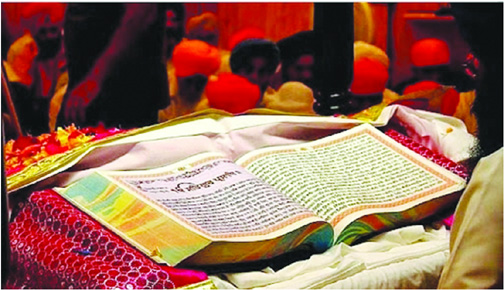
The compilation of the Sikh scripture Shri Guru Granth Sahib was completed on 29 August, 1604, and was first installed inside the Golden Temple in Amritsar on 1 September, 1604
One of the classic simplifications of Sikh history pertains to the preparation of the sacred scripture, the Guru Granth Sahib. The event is generally described in the briefest terms.
The Holy Volume was compiled by Guru Arjan (A.D. 1563-1606) and the first copy was calligraphed by Bhai Gurdas at his dictation-this is all we learn from most of the sources.
What amount of planning, minute attention to detail and labour went into this work is slurred over. An old text which gives some detailed information is the Gurbilas Chhevin Patshahi. Written in AD. 1718, this, in fact, is the oldest source. Although it does not go into the technical and literary minutiae, it narrates the entire process from the beginning of the transcription of the Holy Volume to its installation in the newly built Harmandir Sahib (Golden Temple) at Amritsar.
Why Guru Arjan undertook the task is variously explained. One commonly accepted assumption is that the codification of the Gurus’ compositions into an authorized volume was begun by him with a view to preserving them from garbling by schismatic groups and others. According to the Mahima Prakash (AD. 1776), he set to work with the announcement : As the Panth (Community) has been revealed unto the world, so there must be the Granth (Book), too. The bani, Gurus’ inspifed utterance, had always been the object of highest reverence for the Sikhs as well as for the Gurus themselves. It was equated with the Guru himself. The bani is the Guru and the Guru bani, sang Guru Ram Das in measure Nat Narain. By accumulating the canon, Guru Arjun wished to affix the seal on the sacred word. It was also to be the perennial fountain of inspiration and the means of self-perpetuation for the community.
Guru Arjan called Bhai Gurdas to his presence and expressed to him the wish that the compositions of the Gurus as well as those of some of the saints and sufis be collected. Massages were sent to the disciples to gather and transmit to him the hymns of his predecessors.
Baba Mohan, son of Guru Amar Das, Nanak III, had two manuscript collections of the Gurus’ hymns inherited from his father. Bhai Gurdas travelled to Goindwal to bring these pothis, but the owner refused to see him. Bhai Buddha, one of the oldest Sikhs from Guru Nanak’s days, was similarly turned away from his door. Then Guru Arjun went himself. He sat in the street below Mohan’s attic serenading him on his tambura. Mohan was disarmed to hear the hymh. He came downstairs with the pothis and presented these to the Guru. As says the Gurbilas, the pothis were placed on a palanquin bedecked with precious stones. The Sikhs carried it on their shoulders and Guru Arjun walked behind barefoot. He refused to ride his horse, saying that the pot his were the very spirit of the four Gurus-his predecessors.
The cavalcade brokejourney at Khadur Sahib to make obeisance at shrines sacred to Guru Angad. Two kos from Amritsar, it was received by Hargobind, Guru Arjan’s young son, accompanied by a large number of Sikhs. He bowed at his father’s feet and showered petals in front of the pot his. Guru Arjan, Hargobind, Bhai Gurdas and Bhai Buddha now bore the palanquin on their shoulders and marched towards Amritsar, led by musicians, with flutes and drums. In Amritsar, Guru Arjun first went to the Harimandir to offer karah prasad in gratefulness.
The making of the Granth was no easy task. It involved sustained labour and a rigorous intellectual discipline. Selections had to be made from a vast amount of material. Besides the compositions of the four preceding Gurus and the Guru Arjan who him self was a poet with a rare spiritual insight, there were songs and hymns by saints, both Hindu and Muslim. What was genuine had to be sifted from what was counterfeit. Then the selected material had to be assigned to appropriate musical measures and transcribed in a minutely laid out order.
Guru Arjan carried out the work with extraordinary exactness. He arranged the hymns in thirty different ragas, or musical patterns. A precise method was followed in setting down the compositions. First came sabdas by the Gurus in the order of their succession. Then came chhands, vars, and other poetic forms in a set order. The compositions of the Gurus in each raga were followed by those of the Bhaktas in the same format. Gurmukhi was the script used for the transcription.
A genius, unique in spiritual insight and not unconcerned with methodological design, had created a scripture with an exalted mystical tone and a high degree of organization. It was large in size-nearly 7,000 hymns, comprising compositions of the first five Sikhs Gurus and fifteen Bhaktas and sufis from different parts of India, including Shaikh Farid, Kabir and Ravidas. The Sacred Volume consisted of 974 leaves, or 1948 pages, 12×8, with several blank ones at the end of a raga when there were not sabdas enough to fill the section assigned to it. The site of these marvellous labours is now marked by a shrine called Ramsar.
The completion of the Granth Sahib was celebrated with much jubilation. In thanksgiving, karah prasad was prepared in huge quantities. Sikhs came in large numbers to see the Holy Book. They rejoiced in their hearts by a sight of it and bowed before it in veneration. Among the visitors was Bhai Banno, who had led a group of Sikhs from Mangat, in western Punjab. Guru Arjan, who knew him as a devoted Sikh, instructed him to go to Lahore and have the Book bound. Banno sought the Guru’s permission to be allowed to take the Granth Sahib first to Mangat for the Sikhs there to see it. The Guru allowed this, but enjoined him not to tarry at Mangat, or at any other place, more than a night.
As Banno left Amritsar with his sacred charge, it occurred to him o have a second copy transcribed. The first copy, he argued, would remain with the Guru. There must be an additional one for the sangat. The Guru’s direction was that he should not stay longer than one night at a place, but he had said nothing about the time to be spent on the journey. So he proceeded with his plans and sent a Sikh to purchase paper. He proposed to his companions that they should travel by easy marches of five miles a day. The time thus saved was utilized in transcribing the holy text. Sikhs wrote with love and devotion and nobody shirked his duty whether it was day or night. By the time they reached Lahore, the second copy was ready. But Banno had added to it some apocryphal texts. He had both volumes bound and returned to Amritsar as fast as he could.
At Amritsar, he was received with due ceremony, though Guru Arjun was not a little surprised to see two volumes instead of one. Bhai Banno spoke truthfully: Lord, there is nothing that is hidden from you. This second copy I have had made for the sake of the sangat. But the Guru put his seal only on the volume written by Bhai Gurdas’s hand. He enjoined the Sikhs to own the Granth equal with the Guru and make no distinction between the two. He who would wish to see the Guru, let him see the Granth. He who would seek the Guru’s word, let him read the Granth with love and attention.
Guru Arjan asked his Sikhs where the Granth Sahib be installed. Bhai Buddha said, You are omniscient, Master! But there is no place more suitable than the Harimandir. The Guru was happy to hear these words like one who has sighted the new moon. He then recited the praise of the Harimandir: There is nothing like it in all the three worlds. Harimandir is like the ship-the means for the people to cross over the worldly ocean triumphantly. A new joy pervades here every day. A sight of it annuls all sins.,’
It was decided to spend the night at Ramsar and return to Amritsar the next morning. The Granth Sahib rested on a seat under the canopy, whereas the Guru and the Sikhs slept on the ground.
A disciple had to be chosen to take charge of the Granth Sahib. As says the Gurbilas, Guru Arjan lay awake through the night reflecting on the question. His choice finally fell on Bhai Buddha whose devotion was universally applauded. As they awoke, the Guru and his Sikhs made ablutions in Ramsar. The former thereupon practised his wonted meditation. At dawn, the entire sangat marched towards Harmandir Sahib. Bhai Buddha carried the Holy Book on his head and Guru Arjun walked behind swinging the whisk over it. Musicians sang sabdas. Thus they reached the Harimandir. The Granth Sahib was ceremonially installed in the centre of the inner sanctuary on Bhadon Sudi 1, 1661 BK/August 16, 1604. Bhai Buddha opened it with reverence to obtain from it the divine command, as Guru Arjan stood in attendance behind.





Be the first to comment